2. Where Does the Design Inspiration Come From
Inspiration is the soul of a designer’s creation. Tapio Wirkkala said that only when being inspired by inspiration can a designer continuously to design and create. Once losing creative passion and having no curiosity to everything, a designer should stop creating and try to change the environment or creative content. The sources of inspiration can be nature, tradition and history, technologies and materials, art, architecture, and so on. Generation of design inspiration is based on experience and theoretical knowledge, which may suddenly come into being in the brain when stimulated or triggered by some external conditions. Because inspiration features suddenness, serendipity, and originality, it needs special attention and accumulation in the creative process.
Furniture Design Master from Nature
Natural forms are the soil for breeding design, and the consensus of excellent designers is to take the beauty of nature as their best creative source. Therefore, natural themes can always be found everywhere in classic literature, music, art, and design. Alexander von Humboldt has profoundly shown how nature influences people’s imagination in his book Views of Nature, that is, nature communicates mysteriously with human beings’ “inner feelings”. The book vividly describes nature as a life network, in which plants and animals are interdependent and form a vibrant world, emphasizing “the internal connection of natural forces”.
The greatest lesson nature offers to humanity is freedom, because the balance of nature is maintained by diversity, which in turn can be regarded as a blueprint for political and moral truth. Everything in nature, from the trivial insect and moss to the huge elephant and the towering oak tree, has its unique function, and they form a whole world together. Alvar Aalto, the Finnish design master, is a representative who draws inspiration from nature. Finland’s unique natural environment and humanistic environment have deeply influenced Aalto’s lifelong career, making his design style integrate rationality and romance, showing distinct regional characteristics.
The organic system of biology and nature is like a great mentor to guide and inspire Aalto throughout his design career. However, Aalto is found not to imitate nature directly, but to take some phenomena in nature as design clues, which also conforms to the law of construction in the specific design process (Fig. 0.1–0.4). With unique shapes and design concepts, Aalto has shown Finland’s cultural tradition of respecting nature, and reflected the continuation of Scandinavian context and cultural ecology. Finnish social tradition and climate environment make designers pay more attention to the relationship between design and human, design and nature. Between the two world wars, like Aalto’s design, the design trend in Scandinavian countries combined individual expression, craft tradition, and standardized industrial production. He preferred to use birch, which is native to Finland, and thought that wood
Fig. 0.3
Fig. 0.1
Fig. 0.2
Fig. 0.4
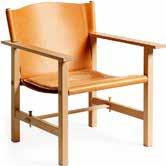
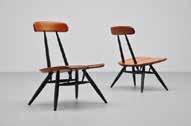
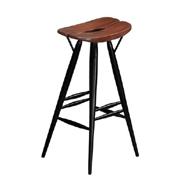
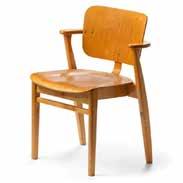
In the field of furniture design, Nordic design is a typical representative cherishing tradition. Sweden is even more attached to tradition, because its long royal tradition gives Swedes more spiritual support and good impression. However, Swedish designers’ vision is not limited to Nordic countries and Europe, but extends to the whole world. The most famous one should be Ake Axelsson, a Swedish contemporary design master. Adkerson’s career originated from the traditional design courses in university. This course required every student to choose a piece of furniture for research and production from all ethnic groups in the world, so Akerson chose an armchair from ancient Egypt. After that, he began to systematically study ancient Egyptian furniture, from copying the original one to innovative design, and finally developed his own unique brand. Adkerson’s design products cherish the furniture tradition of all humankind. Starting from ancient Egypt, he has made special research on ancient Greece, ancient Rome, European Renaissance, English folk furniture, Chinese Ming and Qing furniture, American country furniture, etc. in his nearly 70 years of career, and created a new generation of eyecatching Swedish furniture (Fig. 0.14). Compared with those of Sweden, Finnish designer Aalto’s plywood furniture adopted brand-new material technology, but its modeling language still drew on Finnish and Swedish folk furniture traditions. More than half of the furniture products of Ilmari Tapiovaara, another Finnish designer, originated from the modeling languages of Finnish tradition, British tradition, Danish tradition, and African tradition (Fig. 0.15–0.17).
From the perspective of the East, after the Second World War, with the rapid recovery of Japanese economy, Japanese scholars began to join the ranks of modern furniture research and collection and achieved many research results, which is also the reason why Japan quickly became a design powerhouse after the Second World War. In 2002, under the auspices of Professor Shimazaki Shin, a grand exhibition and international academic seminar were held at the Modern Seat Museum of Musashino Art University, and a monograph The New Theory and Basics of the Modem Chair was published, which listed Chinese Ming chair, British Windsor chair, American Shaker chair and Austrian Thonet chair as the four originators of modern chair. Japan itself has no tradition of chair design because of its long history of sitting on the floor, but after entering the modern society, Japan immediately devoted itself to studying and learning the best chair traditions in the world, and gradually transformed them into elements of contemporary Japanese design. Japanese scholars are fascinated by Nordic chairs represented by those of Denmark and Finland, among whom the most typical and famous one is Professor Noritsugu Oda, who has collected thousands
Fig. 0.14
Fig. 0.17
Fig. 0.16
Fig. 0.15
of chairs by Nordic designers, and extensively studied various collection examples of other museums, and finally published the masterpiece The Illustrated Encyclopedia of Chairs in 2007. In 2014, the famous Hatje Cantz Publishing House in Germany published Finn Juhl and His House by Per H. Hansen (Fig. 0.18), which shows the design charm of the Danish design master Juhl’s chair in all directions, and the strong oriental design mood therein is an important factor in the chair’s popularity with the Japanese public. For the same reason, the works of other Danish design masters such as Wegner and Mogensen and Finnish design masters Aalto and Kukkapuro have been enduring in the Japanese market and design research circles.
Innovation of Technologies and Materials
New design is naturally required in the new era, and the new design must be achieved by new technologies and material processes. With the development of the times, we will constantly discover the weaknesses of hard materials such as synthetic materials and metals, rediscover the value of traditional materials such as wood, bamboo, and rattan, which have been used by human beings for thousands of years, and be more likely to find some brand-new expression modes for furniture in the new era by developing new materials. Design science in the new era will inevitably place new demands on designers. The research and development of materials and processing technologies will no longer be undertaken by scientists and engineers alone. The penetration by designers and architects to materials, process science, and environmental science is becoming fashionable, and the most fashionable design will come from the challenges brought by the research and development of new materials and technologies.
According to the development track of furniture in the world, from the perspective of structural materials, the most important furniture materials are solid wood, plywood, metal, synthetic materials, bamboo, rattan, and cardboard in order, but wooden furniture is still in an absolute dominant position. From the perspective of skin materials, the most widely used furniture materials are solid wood, textile fabrics, leather, plywood, woven bamboo and rattan, synthetic materials, metal, and cardboard in order. Combined with the history development of human furniture, the development of furniture materials can be summarized into four stages: the first stage involves the main materials of ancient furniture from ancient Egypt to 1800, that is, all kinds of solid wood. The second stage involves the main production materials in the development of modern furniture in recent history from 1800 to 1940, including the emergence of bent wood to the development of laminated board and plywood, and
Fig. 0.18
brings different aesthetic characteristics to it. It had been stated in the design drawings of the original easy chair that an additional cushion or rug should be considered, which was reflected in the next easy chair design. This easy chair was the first piece of cushion furniture designed by Rietveld, and the original version can be traced back to 1937. The backrest and the seat of the easy chair are arranged with an angle of 90 degrees and slightly inclined backward, and the intersection point is located on the floor acting as the rear legs of the chair. Framed with wood, the cushion is covered with blue-purple fabric with decorative stitching (Fig. 1.9). According to this design, Metz & Co. made some sofas, which were more comfortable than those with the previous simplified design by Rietveld, to meet the different needs of special customers.
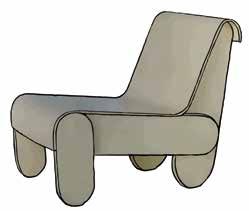
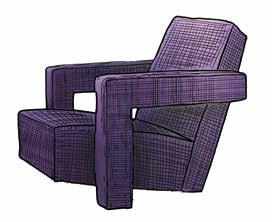
In 1927, Rietveld made the Birza Chair with a piece of fiberboard. After that, to seek a better combination of materials and forms, he created numerous sketches and tried to complete the design with different metal and rattan materials, while completing a small model made of plexiglass and cardboard. However, he was influenced by his youngest son Wim Rietveld, then a metalworker with his own sophisticated machine. He and Wim built a full-size (1:1) aluminum model in 1942, the tubular chair had separated rear legs, seat and side brackets were hand-beaten,
Fig. 1.9
Fig. 1.8
bent and riveted together, and folded edges and round holes improved the structural strength of the material. After World War II, Rietveld’s Aluminium Chair (Fig. 1.10) appeared in the avant-garde magazine Open Oog and was exhibited in the interior art salon in Paris in 1949. Still, Rietveld was unable to find the right manufacturer for the Aluminium Chair, which appeared in its extreme form. Although Rietveld himself admired the aluminum model chair, he also had doubts about it. He thought that only eccentric people would put this chair in the living room. The model was bought by the Stedelijk Museum of Amsterdam in 1950. Ten years later, the pioneers of Delft University of Technology wanted to add this chair to the collection. Therefore, Rietveld, Wim, and Egbert produced three more samples in Epe Workshop with Egbert’s technical instruments in 1960. Perhaps because the aluminum surface began to fall off in the corner, this design was not finally put into mass production.
During the 1920s and 1930s, Rietveld had used bent plywood in some chair designs. After the Second World War, he became interested in plywood again, trying to use available materials to shape the lightest easy chair with the least cost and labor. In 1950, Rietveld designed the easy chair displayed in the hall for Tomado, a Dutch household appliance manufacturer. It consisted of six plywood pieces. After the model was exhibited in Denmark in 1952, it was called Danish Chair (Fig. 1.11).
Rietveld created many masterpieces in his life, which are not “uncomfortable” or “not designed for comfort” as most critics believe today. From the functional point of view, they are very ergonomic and comfortable to use. The author once went to Helsinki Furniture Store to try sitting on the Zig-Zag Chair, and felt that it was no less comfortable
Fig. 1.11
Fig. 1.10
The Pernilla serial chairs have become a symbol of modern leisure and comfort chairs, which has also reflected the evolution way of Mathsson furniture design.
Mathsson’s design clearly declared the birth of an organic design. Although Finnish design master Aalto had earlier launched a batch of more successful and sensational organic designs, their specific construction techniques were completely different, which in itself is a very interesting and worthwhile topic of research. The most striking aspect of his design is the lightness formed by the simple and beautiful structure, and the choice of materials also constitutes a unique feature. The shape of the chair also comes with the human body shape.
Mathsson and 87-year-old Danish mathematician and poet Piet Hein met for the first time in Copenhagen in 1952, and he found Hein to be
Fig. 3.19
Fig. 3.18
a free thinker with similar interests. Hein studied fine arts at the Royal Academy of Fine Arts in Stockholm before turning to philosophy and physical theory in Copenhagen. He designed a “super ellipse” form for Stockholm City Square to facilitate the free flow of traffic as much as possible. In 1964, Mathsson and Hein jointly designed a very beautiful table between rectangular and oval. The idea of super ellipse and span legs of this table came from Hein. Hein’s mathematical formulas show how to create “super circle”, “super ellipse”, and “three super ellipses” (Fig. 3.20). Every point in a graph can be defined mathematically, so the width and length always determine the same shape. Mathsson wrote in 1965: “We always have great admiration for each other and do not hesitate to think together from the right perspective.”
The shape and span legs of the new table led Mathsson into the design of new furniture in 1960s. To promote his new product, Mathsson founded a company called Mathsson International AB in 1965 and changed its name to Bruno Mathsson International AB in 1993. The table with super ellipse and span legs was still the most successful product of Mathsson International AB. At the same time, Mathsson began to try steel pipe structure, and launched a chair with single-axis steel pipe support, named “Jetson”, which was taken from the popular TV series The Jetsons The swivel seat was set on a steel pipe base, which was a revolutionary new structure. In 1965–1966, Mathsson International AB produced the chair. Originally the seat was made of hemp fiber, but now it is made of synthetic fiber. In 2005, Mathsson International AB named the original model “Jetson 66” (Fig. 3.21).
Fig. 3.21
Fig. 3.20
The No. 670 chaise lounge and No. 671 footstool (Fig. 6.22) designed by Eames were other stunning works of his, and this was not the first time he had used the concept of chaise lounge. The Organic Armchair he designed with Eero Shalinen in 1940 is regarded as the originator of the chaise lounge in design history, but the three models made of three connected plywood shells by Eames and his wife in the mid-1940s are regarded as the predecessor of the No. 670 chaise lounge. The final version of the 1956 design featured leather seats, and Eames wanted to convey a warm and familiar feeling like a baseball glove. Conceptually, this work showed the combination of modern technology and traditional leisure design, and it was designed completely for comfort. Each of the three plywood shells had a different shape, one for the seat and the other two for the two-part backrest encircling the body. Three leather cushions filled with feathers and fluff were fastened to the shells by buttons and used in conjunction with two separate foam-filled leather armrests. To save production time, the cushions used for backrest and footstool were the same. Two angle steel pieces hidden under the seat connected the seat shell and the backrest of the chair, and the two shells of the backrest of the chair were connected by two aluminum pipes. Cushions, brackets, multiple screws, decorative rivets, and bumpers made the structure more complete, and ensured good seat flexibility, making the chaise lounge a highly comfortable chair. The main body of the chaise lounge was located on a swivel five-star base made of die-cast aluminum, and the footstool was located on a four-star base that could not swivel. This combination of molded plywood baseplate and leather cushion was also very creative, and later designers developed cushion surface material technique on

Fig. 6.22
this basis. Since the design and production of No. 670 chaise lounge in 1956, almost all the main components have been retained to this day. The Eames’ other designs may be more popular in terms of sales volume, but this luxurious and prestigious chaise lounge has been their most famous work so far.
Since then, the Eames’ design creativity has continuously led to creative furniture products, such as the aluminum furniture series in 1958. No. 684 Alu Lounge Chair (Fig. 6.23) was researched and developed by Eames and his wife in 1957, and only one year later, it reached the phase where it could be continuously produced. Compared with other designs in Eames’ office, this work was completed in a very short time, which was due to the designer’s accumulated experience in different techniques and materials. Alu Lounge Chair included a chair and a chaise lounge, including armrest version (Fig. 6.24) and no armrest version (Fig. 6.25). This series also included a footstool (Fig. 6.26) and a matched table with four-star base. Aluminum is the wisest choice for weatherproof furniture
Fig. 6.26
Fig. 6.25
Fig. 6.24
Fig. 6.23
Another foreign traditional design that attracted Wegner was the Windsor chair of Britain. At that time, many designers started their own design conception on the basis of Windsor Chair, forming a huge Windsor Chair series. Wegner’s interpretation of the Windsor Chair stood out, because he had measured an old British Windsor Chair at the Museum of Applied Art in Copenhagen when he was a student. In 1947, his JH550/ Peacock Chair (Fig. 8.1) immediately became the focus of public attention and soon gained extensive international interest. He turned the back of the traditional Windsor Chair into a decorative, round iconic element, and because of this backrest made of scattered slats, designer Juhl named this design Wegner Peacock Chair. In addition to good decoration, the chair functioned well, and to ensure comfort in use, the slats on the backrest were flattened, and the armrests were made of teak to prevent dust from entering and made the chair fit with the matching table.
JH501/ Round Chair (Fig. 8.2), designed by Wegner in 1949, was described as the most beautiful chair in design history. This classic work simplified the Chinese Ming-style round chair to only the most basic components, but each component was refined to the point where more was too heavy and less was too light. Wegner omitted the vertical element of the backrest and provided a high horizontal backrest to support the lumbar spine, and the backrest further transitioned to propeller-shaped armrests. These organic shapes were inspired by traditional tools such as axe handle and oar. Even though this form produced a sculptural appearance, every aspect of the chair could be attributed to function and construction. The tapered legs with groove were the widest at the position connecting with the seat, and were slightly tilted to maintain stability. The rattan-woven seat surface added a light and transparent appearance to the chair. In the first version in 1949, the backrest was wrapped with rattan to hide the seams between the three pieces of wood that formed the backrest and armrests. When seat cushion appeared in 1950, Wegner removed the rattan and introduced stronger and decorative wooden mortise and tenon to connect the three pieces of wood. The Round Chair marked Wegner’s international breakthrough, with the original four copies made in the studio of Johannes Hansen and exhibited at Copenhagen’s Museum of Applied Art in 1949. This chair was suitable for many occasions and achieved great commercial success at home and abroad.
Like Round Chair, his early designs were originally created for Danish craft production, but he quickly turned to machine-friendly products such as the CH24/Y/Wishbone Chair (Fig. 8.3). Perhaps inspired by the V-shaped back of the traditional Windsor Chair, Wegner modified the chair designed in 1944, and he split the back into a Y shape. This chair was aptly named, and its rear legs supported the round backrest and
Fig. 8.3
Fig. 8.2
Fig. 8.1
armrests, forming the shape of an hourglass. What was impressive was that it combined several classic furniture designs: antique klismos chair, traditional Chinese chair, church chair, Thonet bent wood furniture and Windsor chair. Y/Wishbone Chair quickly became Wegner’s favorite design and a representative of mass-produced Danish furniture, a testament to his ability to combine innovative manufacturing methods with traditional craft of cabinetmakers.
JH512/Folding Chair (Fig. 8.4) was inspired by Mies’ Barcelona Chair, which was beautiful in shape, and could be conveniently leaned against the wall after folding. Wegner adopted curved legs and backrest to cope with the space constraints of modern apartment rooms by the folding structure and the hook on the bracket between legs. Because the seat frame was integrated with the handles, the rattan on the braided seat surface was interrupted, but it did not affect the use. The added bracket slid into the guide slot below the seat, and its curved form transferred the weight of the load to the legs. When the chair was folded, special accessories could align the curvature of the two parts of the chair. Folding chairs were originally made by Hansen, Wegner’s favorite furniture manufacturer, until PP Furniture took over the production in 1990.
JH511/Dolphin Chair (Fig. 8.5), designed by Wegner in 1950, was a variant of the JH512/Folding Chair. Wegner often tried to integrate the armrests with the legs, but in the Dolphin Chair, they were differentiated from the base frame to form a special shape, just like a dolphin swimming. There were originally two versions of Dolphin Chair with headrest cushions, a shorter chaise lounge, and an integrated footstool, is the version shown here. Dolphin Chair was only produced as a limited version in the 1950s, but it marked the beginning of Wegner’s large leisure furniture design, which led to many variants of this type of furniture.
Fig. 8.5
Fig. 8.4
chair arrangement into a miniature interior landscape. He had been fascinated by oriental philosophy since 1960s. In 1961, he went to India to collect folk styles and designed a batch of works full of oriental traditional styles. He was convinced that the design process was not completed when a product was put into production, but when the owner began to use it. The flying carpet leisure chair was designed as a presence device for recreation around the user or within the device. The design was one of only a few pieces of furniture designed by Sottsass that were produced in series. Although small in number, it became a clear representative of the anti-design or radical design movement of that era.
In 1978, at the invitation of the Berlin municipal government, Sottsass put forward suggestions on the reconstruction project of the city’s Museum of Modern Art. The following year, Sottsass joined the Alchimia Studio, which was composed of a group of designers who thought they were the new avant-garde of Italian design. In the Structures Tremble Table, designed by him in Alchimia Studio, wavy lines were used as table legs, and the glass tabletop looked unstable on the undulating table legs (Fig. 10.6). This table, like Alchimia’s other works, imitated the style of modernist design, while being reminiscent of kitsch patterns. This work represented Sottsass’ growing criticism of rationalism and functionalism, and was typical design developed by the postmodernist in the late 1970s.
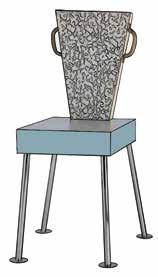
Solid color Dining Chair (Seggiolina da Pranzo) (Fig. 10.7) designed by Sottsass from 1979 to 1980 was reminiscent of simple kitchen chairs in the 1950s. His abstract design had the characteristics of box-like form and simplicity. The inverted trapezoidal backrest seemed familiar, but the side handles seemed to be an unstable choice: who would hold them? To help move the chair? Whatever their purpose, combined with slightly sloping rear legs and round flat chrome-plated leg pads, the chair took on a creature-like form and looked sturdy and brisk. Alchimia Studio produced and sold only the small version of the dining chair, which was exhibited at the Linz Design Exhibition Forum in 1980.
Alchimia’s eclectic and interesting approach foreshadowed all aspects of the Memphis Group initiated by Sottsass in 1981. After the establishment of Memphis Group, Sottsass became the spiritual mentor of young and middle-aged designers in this group with his years of reputation. This design group was one of the protagonists in the postmodernist design movement in the 1980s, and had a great influence on furniture design, decorative art, and other fields in the world.
Carlton Bookshelf (Fig. 10.8) was one of the first collection in Memphis, and its interesting wooden structures could be disassembled at any time for transportation purposes. The side panels tilted outward, which made the product full of dynamic expression. The structure of the bookshelf
Fig. 10.7
Fig. 10.6
was stabilized by triangular wedges, and colorful laminated boards helped to create a bright and cheerful overall impression. Carlton Bookshelf showed the sources of inspiration and reference materials—from comics, advertisements and computer world to dazzling colors, with bold patterns and startling structural contrast. The resulting aesthetic concept rejected simplicity, logic, and clarity, which was obviously related to his early creative stage. The first replicas of Carlton Bookshelf, like other objects in Memphis, were made by carpenter Renzo Brugola, with whom Sottsass had been in cooperation since the 1950s. Although only fifty bookshelves were sold in the 1980s, it was still one of the most depicted Memphis objects and one of the postmodernist iconic designs.
At the first Memphis exhibition in Milan in 1981, Sottsass exhibited several colorful and commemorative designs, including Casablanca Cabinet (Fig. 10.9) and Carlton Bookshelf. In the 1980s, besides designing furniture, metal utensils, and glassware for Memphis, Sottsass also designed jewelry for Cleto Munari Company, metal utensils for Alessi Company, furniture, pottery, and glassware for Milan Design Gallery, and tableware for Swid Powell Company. It was not until 1988 that he disbanded this sensational design group. While carrying out extensive industrial design, Sottsass also completed a series of architectural design projects, such as Wolf House in Colorado, USA from 1987 to 1988, Esprit Showroom in Wels, Austria, Zibibbo Bar in Fukuoka, Japan in 1988 and Cei House in Florence from 1989 to 1992.
Fig. 10.8
Fig. 10.9
Influenced by postmodernist style in the 1980s, Kukkapuro tried to create a decorative functionalism style, combining aesthetic elements with functionalism. In 1982, he brought the Experiment series of postmodern furniture (Fig. 12.8) to Milan Fair and immediately impressed the audience. The structural parts and armrests of the chair were designed in bright colors and diversified shapes, and were assembled with other standardized components.
In 2009, at the Finland International Ecological Design Special Exhibition, the Flash Chair designed by Kukkapuro became the perfect symbol of his ecological thought. Lightning Chair was mainly made of native birch wood in Finland, which was composed of simple and regular geometric components and could be easily assembled. It was a lightweight and environmentally friendly armchair, suitable for use in various environments and public places.
In the past ten years, the East-West Furniture Series designed by Kukkapuro have re-expressed the image of Chinese traditional furniture with Nordic modern design technique. He has a special preference for Chinese wood mortise and tenon technique, and absorbs the functions and forms of traditional furniture in the Eastern and Western furniture series, exploring “New Chinesism” with the spirit of modern re-creation. This series of furniture takes bamboo material as the main material and is produced by Yinshi Furniture Factory in Wuxi, China. Dragon Chair (Fig. 12.9) is one of the representative works, designed by Kukkapuro and Fang Hai, which perfectly combines ergonomics in Chinese Ming furniture with modern ergonomics in Nordic design. The prototype of Dragon Chair comes from the round-backed armchair in Ming furniture, and
Fig. 12.8
Fig. 12.7
its horseshoe-shaped armrests connect the backrest with the legs of the chair, which not only expands the freedom of the user’s sitting posture, but also provides a more comfortable placement mode for the arms. The strip-shaped back plate of the chair is also a symbol of traditional Chinese furniture, providing comfortable support for the body back.
Kukkapuro is one of the most award-winning designers in the 20th century. During the 50 years in the second half of the 20th century, he almost won all the famous awards related to interior and furniture design at home and abroad, totaling forty awards, with an average of one award every year. These awards are obvious signs of the success of the designer, but for the furniture products closely related to people’s daily life. The most important sign of its design success should be the recognition and appreciation of the majority of users. Kukkapuro is one of a few design masters who have succeeded in both aspects.
Like many contemporary design masters, Kukkapuro also worked in diverse design fields such as lamps, telephones, refrigerators, agricultural machinery, graphic design, etc., where he achieved notable results. The architecture he designed for his office is a complete work of art, and “Dream Space” created for Lahti Furniture Fair in 1987 has put him at the forefront of modern space design. In 1988, the Finnish President awarded Kukkapuro the highest artistic title of “Professor of Art”. As a famous professor, Kukkapuro’s main teaching activities are in the Department of Interior and Furniture of Helsinki University of Art and Design and the Department of Architecture of Helsinki University of Technology. In addition, he has served as a visiting professor at three British universities, including the Royal College of Art in London. He often travels to Sweden, Denmark, Norway, Germany, France, Japan, Italy, Spain, Australia, the United States, China, and other countries to give lectures. Because of his teaching career for many years, his influence on the younger generation of designers is self-evident, and makes modern Finnish design always focus on the “people-oriented” design purpose.
Born in 1939 in Stranda on the southwest coast of Norway, Opsvik is famous for designing creative chairs and ergonomic chairs, and is an important designer in the history of Norwegian industrial design. From 1959 to 1963, Opsvik studied at the University of Applied Arts in Bergen and in 1964 at the State University of Applied Arts in Oslo. During this period, he worked for Tandberg Company as a radio designer. In 1970, he won a scholarship from the Norwegian Design Council and went to Essen, Germany, to study ergonomics with Ulrich Burandt at the
2. Peter Opsvik (1939–2024)
Fig. 12.9
two versions with armrests (Fig. 15.13) and without armrests (Fig. 15.14), with the seat and backrest made of linen or leather. The chair is produced by the Finnish company Nikari. In 2012, the company launched a design project called “DESIGNS FOR NATURE” in cooperation with the Finnish World Wildlife Fund (WWF), and launched a product every month, some of which proceeds will be donated to World Wildlife Fund. The rustic features of the chair were an anti-style expression, and might also
Fig. 15.14
Fig. 15.13
Fig. 15.12
Fig. 15.11
be the designer’s understanding of the atmosphere of Finnish rural life. Soft Modular Sofa (Fig. 15.15) was produced by Vitra Company, which was an interpretation of modern classic low modular sofa emphasizing horizontal plane. The proportion of the sofa was elaborately designed, soft and comfortable, and the detailed decoration highlighted the pure appearance of this kind of sofa, conforming to his extraordinary design concept.
Morrison once tried designing an easy-to-use kitchen chair and thought about how to make this new chair out of plastic. It took him two to three years to make five or six prototypes, but none of them were in the most classic style. For visual aesthetics and ergonomic reasons, this plastic (APC) chair (Fig. 15.16) consisted of three parts: molded frame, seat, and backrest. It was reminiscent of the simple classic wooden chair. Now the classic wooden chair is re-presented with a new material, reflecting great progress in appearance and function. The structural design of the chair is relatively simple, but the technical development is quite complicated. To enhance the comfort of use, the pivot with rubber shock absorber is used at the connection between the backrest and the whole chair structure, so that the backrest can change slightly according to the movement of the sitting person. The plastic chair is made of polypropylene, a small amount of polyamide, and two steel pins, which are used to hold the backrest on the fulcrum and provide the pivot. The chair structure is made by gasassisted injection molding, meaning it is hollowed to provide a lightweight and sturdy tubular structure. Before the final mold is machined, many simulation tests have been carried out to ensure the robustness and loadbearing capacity of the chair. Besides, the materials used are recyclable. The chair can be used indoors, and is available in white, black, yellow, dark gray, ice gray, and other colors (Fig. 15.17). Some versions have slightly darker frame color, while the seat and backrest are in colors with
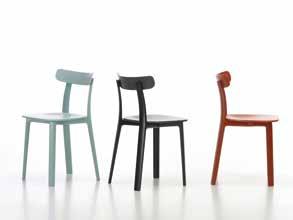

Fig. 15.15
Fig. 15.17
Fig. 15.16
development was also recorded in the solo exhibition of Grcic held by the Bavarian National Museum in Munich in 2016.
The Myto Chair (Fig. 15.22), which he designed from 2006 to 2007, was one of the first chairs made entirely of plastic without rear legs since Panton. BASF Company had been trying to find new uses for polybutylene terephthalate, a material mainly used in the automobile industry, and now also for other uses. Due to its chemical and physical properties, the ultrahigh speed plastic flow for injection molding rapidly enters the mold, thus creating a highly durable structure. This makes Myto Chair have a sturdy support frame, and longitudinal perforations in the backrest and seat facilitate ventilation and drainage of rainwater when the chair is used outdoors. It emphasizes a technical aesthetic, which is also a feature of many Grcic’s designs.
Unlike the other categories, Rival Chair is a unique chair with inclined four legs and inward-curved armrests focusing on a point (Fig. 15.23). The chair is made of lightweight wood, and thanks to the skillful control of wood and plywood by modern technologies, making the wood has a plastic texture. It was produced by Artek Furniture company in Finland, founded by Aalto, so Grcic specially chose the wood, a signature of Finnish design, to make this chair. Designed as a home work chair, the Rival Chair has a cushion on the seat surface, which can swivel while concealing the sophisticated technology of the era. Because of the connection between the sitting surface and the base, the user can swivel back and forth as if in an office, and its bold colors also bring a relaxed atmosphere to the home. Fig. 15.24 is the 360° work chair designed by Grcic for Magis Company. It is a combination of stool and chair. As implied by its name, it can swivel
Fig. 15.22
Fig. 15.24
Fig. 15.23
360 degrees. Therefore, instead of providing a chair for the user to keep a sitting posture for a long time, it allows people to use it dynamically and briefly with improvisation.
The polyhedron series include Chaos single-person sofa (Fig. 15.25), Odin Sofa (Fig. 15.26), Mars Chair (Fig. 15.27), Pallas Table, and many other works, all of which consist of polyhedrons between regular and irregular. Among them, Chaos single-person sofa has a narrow but long sitting surface. When sitting on it, the body leans back as a whole, and the weight of the body is distributed to the backrest, unlike traditional seats making the hips or seats bear most of the pressure (Fig. 15.28). The upper part of Odin Sofa protrudes over the lower part and hangs in the air, and the two seating surfaces form a certain angle. This design makes two people close together, and the inward surrounding of armrests and backrest also implies a private relationship, so the furniture can express people’s ideal relationship and narrow the distance between people. In addition to the sunken seat surface of Mars Chair, the prominent feature of the seat is similar to that of Odin Sofa. The backrest of the chair is
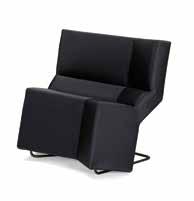
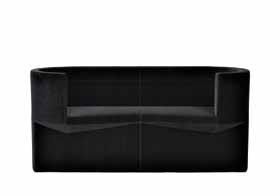

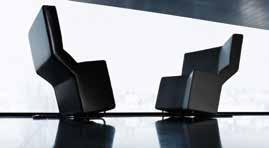
Fig. 15.28
Fig. 15.27
Fig. 15.26
Fig. 15.25
Published in Australia in 2025 by
The Images Publishing Group Pty Ltd
ABN 89 059 734 431
Offices
Melbourne
Waterman Business Centre
Suite 64, Level 2 UL40 1341 Dandenong Road
Chadstone, Victoria 3148
Australia
Tel: +61 3 8564 8122
books@imagespublishing.com www.imagespublishing.com
New York
6 West 18th Street 4B
New York, NY 10011
United States
Tel: +1 212 645 1111
Copyright © Fang Hai, An Shun 2025
The Images Publishing Group Reference Number: GX003
Shanghai
6F, Building C, 838 Guangji Road
Hongkou District, Shanghai 200434
China
Tel: +86 021 31260822
All rights reserved. Apart from any fair dealing for the purposes of private study, research, criticism or review as permitted under the Copyright Act, no part of this publication may be reproduced, stored in a retrieval system, or transmitted in any form by any means, electronic, mechanical, photocopying, recording or otherwise, without the written permission of the publisher.
Title: Fifteen Lectures on Modern Furniture Design Methods
Author: Fang Hai,An Shun
ISBN: 9781764075428
EU GPSR Authorised Representative: Easy Access System Europe Oü Company Registration ID: 16879218 | Address: Mustamäe tee 50, 10621 Tallinn, Estonia Email: gpsr@easproject.com | Tel: +358 40 500 3575
Printed by Everbest Printing Investment Limited, in Hong Kong/China
IMAGES has included on its website a page for special notices in relation to this and its other publications. Please visit www.imagespublishing.com
Every effort has been made to trace the original source of copyright material contained in this book. The publishers would be pleased to hear from copyright holders to rectify any errors or omissions. The information and illustrations in this publication have been prepared and supplied by Fang Hai, An Shun. While all reasonable efforts have been made to ensure accuracy, the publishers do not, under any circumstances, accept responsibility for errors, omissions, and representations, express or implied.

















































